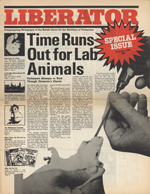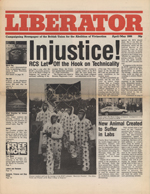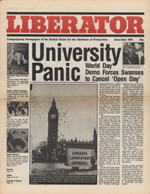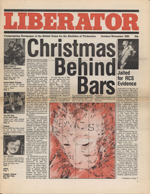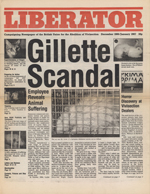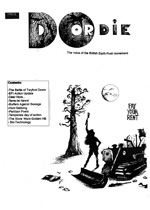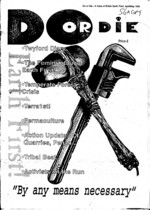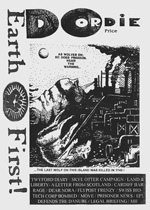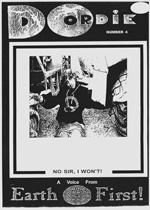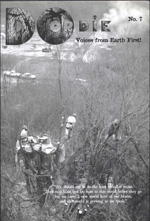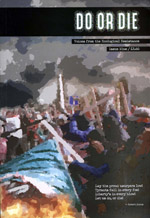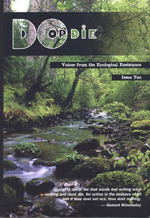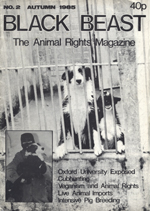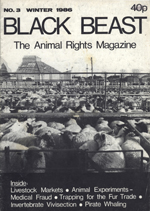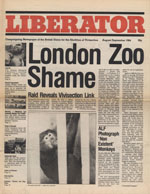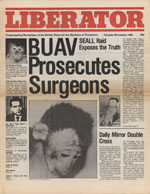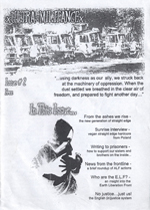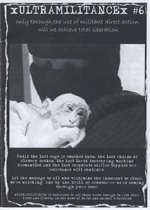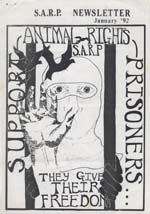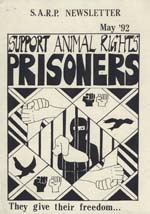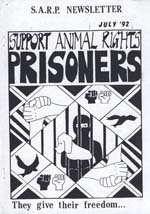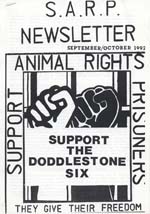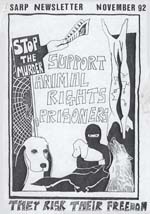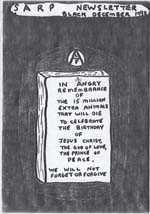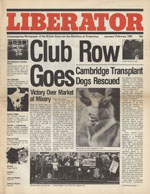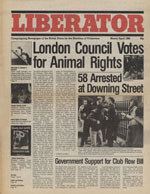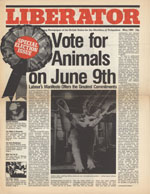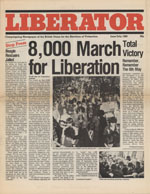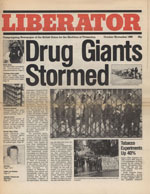The Archives
-
Audio / Music, One-off publications
Still Angry?
11.07.15 | PermalinkStill Angry? The Compilation Tape and Fanzine: A Benefit for the Toronto ALFSG (1987, Toronto, Canada)
The Toronto ALFSG released many of the publications on this site and were one of the best sources of information on direct action for non-humans in the 1980s. In order to financially support their work, they released this cassette and zine compilation in 1987. After searching for it since the start of TALON, we finally found a copy just a few short months ago.
Hailing primarily from Europe, North America, and South Africa, the bands on this compilation run the gamut of punk sub-genres and fans of fast, loud music should find something they enjoy. The zine and liner notes are typical of their era- cut and paste style graphics, juvenile interviews, and plenty of righteous frustration with law and order.
Due to a file error, we currently only have Side A of the cassette digitized. Please accept our apologies, we will post the full cassette soon.
[soundcloud url=”https://api.soundcloud.com/playlists/163187882″ params=”auto_play=false&hide_related=false&show_comments=true&show_user=true&show_reposts=false&visual=true” width=”100%” height=”450″ iframe=”true” /]
…
-
Campaign newsletters
Action for Animals #1
12.17.14 | PermalinkAction For Animals # 1 – (1989, Essex, England)
While there isn’t much stand-alone importance to this particular publication, the critical role played by grassroots newsletters in the 1980s in undeniable. Prior to the popular use of the internet local groups were run by a small core of organizers who communicated with their own membership and the broader public using these cheaply produced zines. Ideology, protest dates, campaign information, news from other organizations, fundraising efforts, and prisoner support were all shared, and with results that often dwarf what we see from Facebook based organizing.
Action for Animals produced a newsletter very typical of its era and geography. Those of you who take the time to look closer at this publication will notice excerpts from the London Greenpeace leaflet (co-written, as it turns out, by an undercover cop) that lead to the McLibel case. Also of note are AFA’s anti-capitalism sentiment, and the diversity of actions embraced by their group- from Christmas carolling to support for underground direct action.
…
-
BUAV Liberator, Most Popular
BUAV Liberator 1986
10.15.14 | PermalinkBUAV Liberator (1986. London, England)
“Although the BUAV as a limited company can only organize legal activity, we aim to complement and support direct action whenever possible.” BUAV editorial, April-May 1986
Frequent readers of the site will be aware that TALON’s volunteers are big fans of the BUAV Liberator. Not only do its old pulp pages bleed with animal lib history, but the politics represented by BUAV at that time were among the most progressive (and occasionally radical) of any major national non-profit working for non-humans.
During this era the British Union to Abolish Vivisection supported any direct action which did not include pre-meditated violence towards a human, and proudly advocated a broad array of strategies and tactics. From letter writing to sabotage, legislation to arson, the BUAV gave coverage to nearly all of the activism in England at the time- and that is only a small part of what makes these papers so great.
Year after year, each volume of the Liberator gives us clues as to the mood within the movement. In 1986 for example, we see a somber tone set over the movement as the Liberation League’s began to fold, the government passed legislation expanding vivisection, and dozens of activists began prison sentences over lab raids. This blow to activist morale in 1986 was perhaps most visible in the actions of Robert Blackman, a young man who entered the Colchester cattle market and self immolated to protest the sell of living beings. His mother later said that “He gave his life because he thought the cruelty would never stop.”
Interestingly, 1986 was also a year filled with inspiring actions for animals. Issue after issue details labs shut down, vivisectors ending their careers, a dramatic rise in veganism and vegetarianism among the general public, and non-humans having their first taste of freedom. It is only within the context of the meteoric rise of animal rights in the earlier part of the 1980s could this year be seen as any kind of a failure. Indeed, if the level of activism in these issues were to occur today morale would sky rocket and great breakthroughs could be made- and all of us should take that as a challenge!
…
-
Do or Die, Most Popular, Periodicals
Do or Die – The Complete Set!
04.09.14 | PermalinkDo Or Die #1-10 (1993-2003, Brighton, England.)
A few years ago a friend asked me if I had a complete set of Do or Die, the British Earth First! publication that inspired and incited eco-warriors throughout the 1990s and early 2000s. At one time I did have them, but they had long since been stolen by a Joint Terrorism Task Force.
After a brief discussion, we decided that Do or Die was too important to fade into obscurity. We began tracking down each issue, and decided that while we were at it we ought to archive some other publications as well. That effort is how this web site began, and now, thanks to 56a infoshop of South London and Tim @ NEDS Northampton, we can finally share the very rare issue #2. This completes our collection, and our original mission as well.
When read as a set, Do or Die is a chronicle of people from across the globe counter-striking capitalism, ecocide, and the state. Each issue is better than the last, but more importantly, each page is a spark licking at the fuse of the bomb that is your heart. Once lit, you’ll know that these pages are not mere history, but a reminder that we can explode onto the world stage like the fighters before us have. Do or die, now is the time to rise.
…
-
Periodicals
Black Beast #2-3
02.07.14 | PermalinkBLACK BEAST – Issues 2 & 3 (1985-1986, Oxford, UK)
Taking it’s name from the french term “bête noire,” Black Beast ran for 3 issues before changing it’s title to Turning Point.
Black Beast covered all aspects of animal liberation protest and resistance, from sign holding demonstrations, to lab raids, alongside investigations into various abuses of non-humans. It’s politics were pro-direct action, but anti-militarism, and editorials inside criticized groups like the Animal Rights Militia. Articles were published without bylines, and every aspect of the magazine was anonymous. This made it an attractive forum for groups like the Central Animal Liberation League, who sent in a first hand account of the infamous Park Farm raid at Oxford that freed 32 dogs. One issue even contains an interview with a pre-off-the-deep-end Gary Francione detailing his support for the Animal Liberation Front!
The magazine was well written, nicely produced, and also very rare! TALON is seeking a copy of issue #1. If you can share one with us, please contact us HERE.
…
-
BUAV Liberator, Periodicals
BUAV Liberator 1984
12.25.13 | PermalinkBUAV Liberator (1984. London, England)
As our holiday gift to you we present the complete 1984 volume of BUAV’s Liberator. This classic publication comes from an optimistic time in our movement when national non-profits were still working with radicals, articles about legislative efforts ran alongside tales of lab break ins, and the struggle for non-human liberation was growing by leaps and bounds. We love this newspaper, and hope that it reminds all of you in the trenches that we are strongest when we work together.
(Editor’s note: When we originally published this post we mistakenly missed the December 84/ January 85 edition. We apologize for the error and have now included the missing issue in our archive.)
…
-
Periodicals
X UltraMilitance X #2, 6
11.19.13 | PermalinkXUltraMilitanceX #2, 6 (2003 – 2005. Bursledon, Hants, England)
While I am not the biggest fan of “vegan straight edge” publications, XUltraMilitanceX manages to fit a few positive aspects into it’s otherwise formulaic, religiously worded format. Between the band interviews, sobriety cheerleading, and calls to “destroy Babylon,” there are some good articles on the history of the movement and a slightly deeper analysis of capitalism, the state, and human supremacy than I would expect from a zine named after an Earth Crisis song. Produced by a former anti-HLS prisoner, this was also one of the few XVX zines written by someone willing to actually act on the lyrics and liner notes that inspired them to begin with.
Issue #2 and #6 are very rare and took us a few years to find, but they complete our collection of this popular zine. The other issues can be found HERE.
…
-
One-off publications
Inside the Cages: animal liberation and imprisonment
08.27.13 | PermalinkInside the Cages (2013. South London, England)
Back in the early 2000’s I was invited to speak at World Day for Animals in Laboratories in Cambridge. It was my first time out of North America, and I was excited to meet our British counterparts in the movement for non-humans. Originally my trip was planned for two short weeks, but shortly after my arrival I got some news that ended up extending my stay: my house was raided by a Joint Terrorism Task Force. “Don’t fly back until we know what’s going on,” my attorney warned. Since I was stranded abroad I figured I may as well get some activism done. Introductions were made, and soon I found myself going out on office invasions and event disruptions across England and Germany.
One of the people I met during those hectic months was a young anarchist named Lewis. He was smart, daring, and had a contagious smile that appeared whenever mischief was being discussed… or carried out! Lewis was no adventurist though, his motivations were sincere and his work ethic solid. By the time I left Europe to face the situation awaiting me in the U.S. I had developed a deep respect for his fighting spirit.
Like so many of the people I respect, it wasn’t long before Lewis found himself on the “wrong” side of the law. After being charged for carrying out ALF actions, Lewis refused to turn informant and was sentenced to prison time and supervised probation. “Inside the Cages” is his account of that experience. The final chapter, which details Lewis’ interactions with the probation system is highly recommended.
…
-
Campaign newsletters, Periodicals
Support Animal Rights Prisoners Newsletters: Year Two
07.30.13 | PermalinkS.A.R.P. Newsletter #6-11 (1992 – Northampton, England)
One of the big frustrations of working on the TALON site is that the materials we archive contain so much information it becomes difficult to organize and contextualize it all. Our posting of the Barry Horne SARP newsletter revival has made this sense of frustration more distinct than ever.
1992 was an eventful year for the movement: Mike Hill was murdered by hunter Alan Summersgill, the Doddlestone six were arrested protesting that murder, in North America Darren Thurston was arrested, Ronnie Lee was released, Kieth Mann was on remand and just about to escape from prison… This is just the tip of the iceberg as far as the significant events that took place over twelve long months twenty one years passed. We could spend pages discussing how these incidents shaped the future, how recent revelations about police informants in the UK have changed our understanding of old arrests, and so on. Unfortunately there is no time to pull at all of these strings- but the SARP newsletters certainly will provide inquisitive readers with many threads of their own to pull. From details of Operation Fox to “Laugh Along with the ALF,” each newsletter if filled with intriguing bits of our collective history.
…
-
BUAV Liberator, Periodicals
BUAV Liberator – 1983
07.16.13 | PermalinkBUAV Liberator (1983. London, England)
The British Union for the Abolition of Vivisection was first established in 1898 by the Irish feminist Frances Power Cobbe. In its long history it has rarely been effective as a fighting force for non-humans, but every so often the organization has a flash of brilliance. In the 1980s, sparked to greater militancy by an explosion of youth activism against vivisection, one of these “flashes” became a conflagration that lasted more than five years.
After shedding their corporate image for something with a little more edge, the BUAV’s publication, “Liberator” became the most important publication during England’s rise of animal lib militancy. While the legislative and educational work of the Union continued, they also incorporated support for direct action. The results were spectacular. Mainstream acceptance of the underground increased, protests grew in size, more people began directly saving non-humans from places of abuse, the grassroots expanded, and unity across the tactical spectrum meant less infighting and more progress for all parties involved.
As always, marriages between moderates and radicals are unstable, and like many others this one ended in a bitter divorce. The BUAV kicked Ronnie Lee’s ALF Press Office out of their building, the SG denounced BUAV as do-nothing liberals, and direct action became harder to support as groups like ARM started sending postal bombs. Still, it was a productive relationship while it lasted, and these newspapers provide an interesting look into just what a national organization for animals can accomplish.
…



